
|

Behold! The Walls of Windy Ilios
A Cartoonist's Adventures in Troy
By Eric Shanower
PART FOUR
Back to Part Three
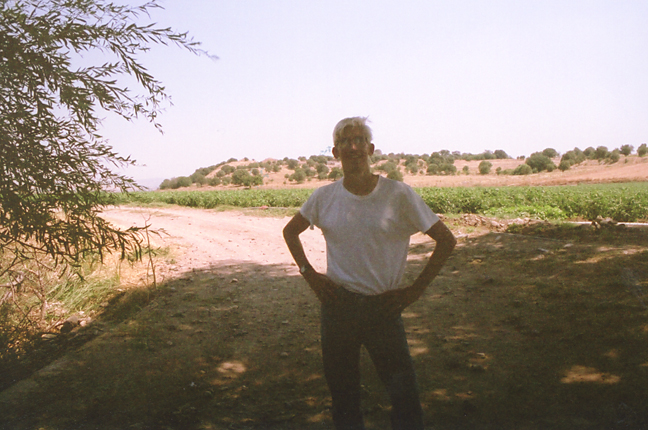
Eric Shanower with the Hill of Hisarlık, site of Troy,
in the background.
In Homer's Iliad, Achilles chases Hektor past what Homer refers to as "twin sources of the eddying Skamander." One of these springs is hot, the other cold. Attempts over the years to locate actual springs that served as Homer's inspiration have proven inconclusive. The most promising candidates are a group of springs that cover a significant area about twelve kilometers south of Troy next to the town of Pinarbaşi. But none of them are hot springs, and twelve kilometers is a long way to run, even if you're a Homeric hero. How likely is it that Achilles chased Homer past the springs at Pinarbaşi not once but three times?
Other candidates for Homer's springs have been suggested. Mustafa Aşkın, manager of the Hisarlık Hotel, told me that he thinks the spring cave close to the citadel mound is what Homer meant by his springs. But during the Late Bronze Age the spring cave was within the line of the defensive ditch, part of the Lower City of Troy VI, so while it's possible that's what Homer meant, the spring cave doesn't seem a particularly likely candidate to me.
I'd pretty much written off going to Pinarbaşi to look at the springs, but the bus on the way to the Bozcaada ferry had driven through Pinarbaşi. Since I'd be returning through Pinarbaşi on my way back to Troy, I decided to stop there.
Once off the ferry from Bozcaada, I went from bus to bus, asking every driver whether he was going to Pinarbaşi. Finally one said yes. I rode the bus back into Geyikli, but there the driver escorted me off. Seems I'd have to wait for another bus to leave for Pinarbaşi. So I sat for an hour in the bus office, dutifully drinking the çay that the gentleman behind the desk ordered for me.
When I got off the bus in Pinarbaşi, people were congregated in the center of town. I greeted them with "merhaba" (hello) and asked "su?" (water) while pointing to the ground. I figured that the springs were famous enough that they'd know what I meant. They did. They directed me down a street filled by a line of cars, each with a piece of fabric hanging from its driver's side mirror. I thought maybe this was a funeral cortege, but later learned that the fabric identified it as a wedding party.
I walked down the road, heading for an area where clustered trees stood grouped, then crossed a field toward a creek. Turtles slid from the banks into the water at my approach. After a little searching, I came across two springs issuing from the base of a hill. The hill was rocky and dusty. Trees and bushes grew on it, but they looked gray in the glare. Below the hill, all was lush and green.
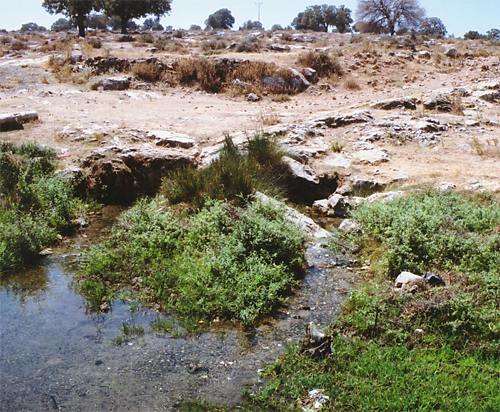
The first two springs at Pinarbaşi.
The hill above is dry.
I walked along a low concrete wall that began near the first two springs. The next spring flowed from a hole in the foundation of a small building, obviously harnessed for some industrial purpose. Beyond, gardens and goat pastures alternated with fields still in their natural states, and through it all flowed water issuing from various sources. I hadn't seen anything like it anywhere else in the area and was awfully glad I'd stopped in Pinarbaşi.
Looking north toward Troy, I could see Keşik Tepe and the Sigeum Ridge. I couldn't make out the Hill of Hisarlık through the haze, but I tried to imagine Hektor running all that distance. Suddenly it didn't seem so far-fetched. It's a long way, but there's no reason to believe that either he or Achilles sprinted the whole time.
The next day was Sunday, the archaeologist's day off. What do archaeologists do on their days off? They go to other archaeological sites! Dr. Gebhard Bieg had asked earlier in the week if I'd like to go to the mountains south of Troy where I could get a good view of the Bay of Edremit and the island of Lesbos, locations in the story of the Trojan War. I hadn't been able to see these features at all from Ayasma, so of course I said yes. I'd probably have agreed no matter where Gebbi planned to go, just for the experience.
So Sunday morning the excavation team van picked me up. Ralf Becks was driving and besides Gebbi there were Ayça Polat and Ivan Pecina. As we approached the mountains, Gebbi pointed to one high, flat ridge and declared it as our destination. Ralf parked the van next to a tavern in the center of a Turkish village high on the mountainside and the five of us began an uphill hike.
After awhile we came to a long hump of tumbled rocks that had once been a wall. Some features of this wall were still detectable. A gate was obvious even to my inexpert eye. We climbed up onto the tumbled rock wall. Ralf and Gebbi began to measure and photograph.
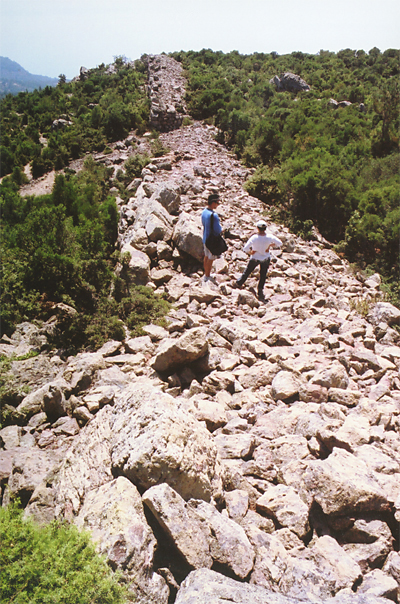
Standing on the ruins of an ancient wall high on the mountain.
Standing near the top of the mountain on this ancient wall I could see everything Gebbi had promised. The views were spectacular--out over the Gulf of Edremit to the Turkish coastline on the east as it continues southward and to Lesbos directly across the water from where we stood. This was the area where Achilles raided towns, countryside, and the island during the Great Foray of the early years of the Trojan War. Unfortunately the haze obscured all detail.
Although I could see what Gebbi had promised, what he hadn't told me was that we were going to spend the next four hours on top of the mountain walking the circuit of this crumbled wall. This was no tourist attraction, this was an authentic archaeological site. It remains unexcavated due to its inaccessibility and the small trees and scrub brush that cover the mountaintop. There were no guard ropes, no signs pointing the way, no guarantee that a rock wouldn't roll out from under one's feet. A stumble could mean a fall down the side of the mountain, or in some places, a plunge over the edge of a cliff.
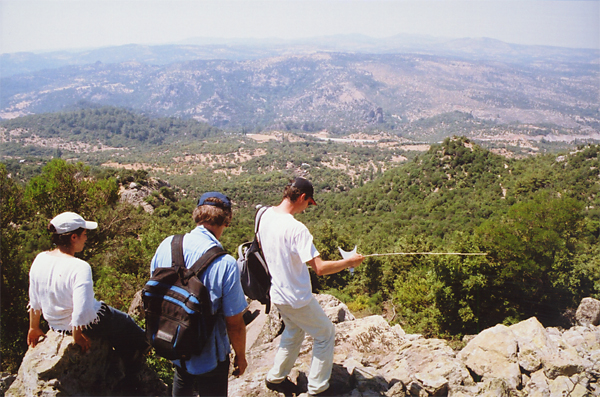
Looking out over the edge of the mountain.
I didn't complain. It was kind of thrilling to follow the archaeologists as they worked. It was hot, too. Whenever we stopped--for measuring and photographing or to decide which way to go next or for a breather and drink of water--Ivan always made sure to stand in a shaded area. He was wearing shorts. I was glad I didn't have bare legs as we pushed through overgrown areas. But when we all checked ourselves for scratches at day's end, Ivan's legs had none. Maybe they teach you how to manage that in archaeology school.
Ralf said that if we became separated, to walk back down the mountain to the village and wait at the tavern. Often Gebbi and he would move on ahead quickly, leaving Ayça, Ivan, and me to bring up the rear. I was determined to keep up. No way was I going to play the Kate Capshaw role in Indiana Jones and the Temple of Doom. At first it did remind me of an Indiana Jones adventure, but quickly that impression struck me as somehow wrong. Compared to this, Indiana Jones seemed fake. Another idea gently nagged at me--what did this remind me of? Then I had it--one of Carl Barks's Uncle Scrooge adventures! I felt like Scrooge or Donald or Huey, Dewey, or Louie, climbing through fabulous ancient ruins and forcing my way through stubborn vegetation, facing danger in search of some stupendous treasure.
Only once did I fall behind. In a wooded area I let the others get a little ahead so that I could pee in private. When I'd zipped up, though, I turned around to find that I was now completely alone. I hurried ahead in the direction they'd gone, but there was no path, and the circuit wall had disappeared at this point. I listened for someone to call me. I kept moving forward through the trees. At last I heard Gebbi faintly calling my name. I was alarmed by just how faintly. I quickly caught up, but the extent to which Gebbi's voice had been muffled by the trees gave me a fright. I didn't let myself become separated again.
I was impressed by the dedication of these archaeologists. Gebbi, in particular, was so enthusiastic and focused that he seemed obsessive-compulsive. I don't mean that with any negative connotation. I'm in complete sympathy with functional obsession-compulsion. Anyone who looks at my artwork can see that. I wish more people in the world had the concentration and dedication that I saw displayed on top of that mountain.
After completely walking around the site, we hiked back down to the village and had something to drink. I'd been taking sips of bottled water all day, but I immediately sucked down two giant lemonades. Then we went to Assos for a late lunch. Assos, both the modern town and the ancient site, is perched on a hilltop. Several times I couldn't watch as Ralf negotiated the van along streets that clung to the hillside.
Then we went swimming in the bay below Assos. This beach was rocky and a little difficult to walk on in bare feet, unlike the sand beaches of the Aegean coast. Gebbi remained on the beach where he fell asleep while the rest of us were in the water. He must have been beat. Treading water, I looked up to the top of the Assos hill on one side and across to Lesbos on the other. It seemed almost unbelievable that I was actually there. For some reason that feeling seemed to occur whenever I was taking a swim.

Nearly lost in haze, the island of Lesbos sits on the horizon across from Assos.
Later we had ice cream cones. Turkish ice cream has a different consistency than ice cream in the USA. They've got different flavors there, too. I liked it, but it wasn't what I was familiar with.
Ralf's K-turn on the narrow cliff road above the beach where we'd parked was impressive. I couldn't imagine doing it myself without sending the vehicle over the edge. I forced myself to stay calm. (Is it starting to seem as though I have issues about other people's driving? Maybe I do.)
Back in Tevfikiye we ate dinner around the corner from Uran's on the open terrace upstairs at Dinç's tavern. Real chicken served there. And Efes beer. That seems to be the standard Turkish beer that people drink. If you want to try Dinç's while you're visiting Troy, walk past Mustafa's, past Uran's, turn left, and immediately across the street is Dinç's tavern. Take the stairway on the left to the second floor.
Monday was my last full day at Troy. A flood channel figures in the chariot race at the funeral games for Patroklus. I spent the morning in the plain west of the site, looking for flood channels, until I finally realized that I'd seen one on my very first day of hiking. I'd actually been in it, I just hadn't realized at the time what it was.
At one point a big golden dog began barking at me, then started following me, still barking. I assume the dog belonged to a goatherd, but there was no goatherd around to call his dog away. I picked up a stone from the road in case the dog attacked. It didn't, but its aggressive barking was unsettling.
After a week and a half of nearly non-stop activity, the heat, the humidity, and the barking dog made me a little weary. I hiked eastward back toward Troy. When I reached the little bridge over the Kalafat Asmak, I lingered in the shade of the trees. This had become my favorite place in the Troad when, days earlier, I'd been walking along the creek, looking for a way to cross. The banks are lined with trees. Leafy branches arch over the bridge, hiding the view beyond. When I'd reached the bridge and crossed it, the branches had seemed to part like a curtain to reveal the Hill of Hisarlık rising just over the next field. I visited that spot several times while I was at Troy, and although I couldn't recapture the first surprise of the effect, the revelatory quality remained. The only thing that marred my pleasure in this spot was the raucous chugging of an irrigation pump beside the bridge. But on my last day in Troy, the irrigation pump had been removed.
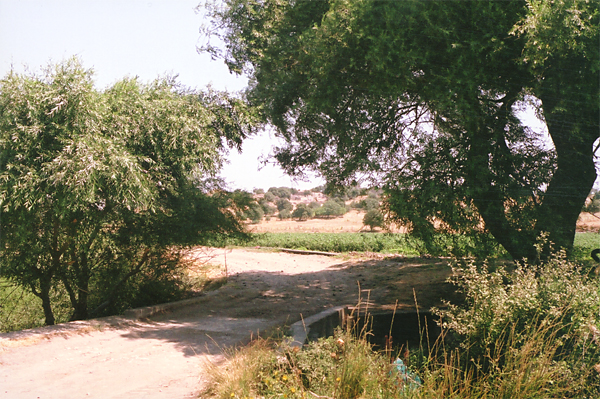
The bridge over the Kalafat Asmak, my favorite spot in Troy.
Beyond the trees rises the Hill of Hisarlık.
My second favorite spot, as I already mentioned, was the fig tree in the center of the citadel. Early in my visit, Liz had casually mentioned that the juice from fig leaves is supposed to be good for getting rid of warts. I had a small wart on the index finger of my left hand--my drawing hand. Occasionally I've had such warts and used Compound W to get rid of them. But I'd had this one for a few years without bothering to do anything about it. Now I picked a leaf from the fig tree and applied the thick, whitish drop of liquid oozing from the end of the stem to the wart on my finger. Liz said I'd have to do that every day. Well, I didn't manage it every single day, but I did it many days while I was in Troy. Often as I passed the fig tree, I'd pick a leaf and apply the gooey stuff to my wart. I'd be careful to let it dry, but soon I'd forget about it, and the little blob of sticky, whitish stuff would rub off. It didn't seem to be causing any change to the wart, but I kept up the ritual simply because it seemed exotic.
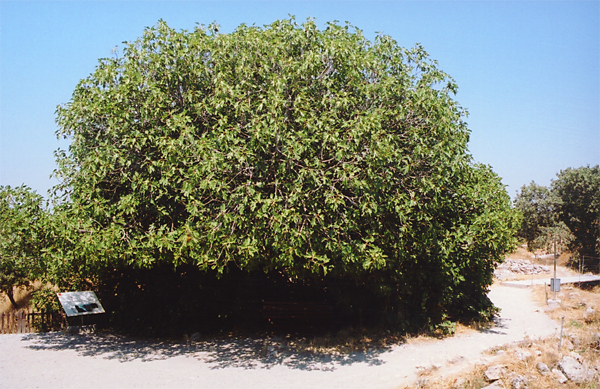
In the center of Troy grows this large fig tree.
Fig trees have a wonderful scent.
I could tell when I was near a fig tree by the delicious smell that filled the air.
Most of the rest of my last day in Troy I spent with the excavation team. I chatted with Peter Jablonka and his wife Mona. At one point Peter had mentioned that he didn't see why I'd come to Troy because everything looked different now than it had in the Bronze Age, the land was seven or eight meters higher. I didn't know exactly how to explain that I'd come for more than just the way things looked. Before I arrived, I'd already known a lot of things about Troy and the surrounding area. But to walk the distances on the plains around Troy that the characters in the story walked, to see exactly what's visible from any given point in the area, to imprint comprehensive portions of the Troad's features onto my brain rather than trying to conjure them up from site plans and photographed fragments in books, to see that the waves of the Aegean Sea are nothing compared to the Pacific rollers at home, to long for my next drink of water under the harsh sun, to feel the wind of windy Ilios blow through my hair--for these and countless other subtleties I had to visit the place. These will enrich the story of Age of Bronze and the way I draw it, sometimes in ways I'll recognize, sometimes in ways I probably won't.
Several years ago a large, sail-like protective cover was erected over a reconstructed mud-brick megaron of Troy II in the center of the site. At first I found it a jarring anachronism, almost as objectionable as the big wooden horse. But in hiking around the plain and coastal areas, I found that the protective cover was an excellent landmark, visible from miles away, signaling Troy's location like a beacon. I came to rely on it as a reference point.
It seems that the earth under the stanchions of the protective cover has been eroding. That afternoon, Peter and Mona Jablonka went to examine the erosion and they invited me to tag along. Of course I joined them. It was always great to follow the excavators through Troy because they didn't stay on the tourist paths, just hopped the wire without a second thought. That meant I could hop the wire, too, and get views of the site that most people couldn't.
That evening, before Ralf took me around to look at things in the Lower Town of Troy VI, he and Ernst Pernicka needed to look at some of the Troy VI citadel structures. I got to go along. Of course I followed them off the tourist path once again. We stood on the citadel walls as Ralf and Ernst conversed in German. I could only follow their discussion in a very general way, mostly picking up clues from their gestures and my own knowledge of the site. At one point it was obvious that a site plan would clarify a point they were discussing, so I offered the one I continually carried in a back pocket. I was overjoyed to be able to supply the project director and one of the primary excavators with a little help. It made me feel as though I was part of Project Troia, albeit in ever so minor a way.
Later Ralf and I walked across the uneven hillside on the mound just northwest of the citadel. Ralf explained that we were walking through old exploratory trenches dug by Carl Blegen and Marion Rawson during the University of Cincinnati's Troy excavation campaign of the 1930s. Suddenly I felt history collapsing in on itself and slamming into me.
I hadn't felt quite this way before--the closest was when I'd been on Tenedos (Bozcaada) and found places closely matching scenes I'd drawn. I'd also felt a twinge of it when Liz had pointed out a mark Dörpfeld had chiselled into a Troy II threshold as a measuring reference. (That chisel mark has worn away to near invisibility in more than a hundred years.) But I hadn't felt this when I'd first entered the site, I hadn't felt this when I saw the famous trenches Heinrich Schliemann had ripped through the citadel. What seems to account for the difference in my reactions was whether I'd known to expect what I was seeing. I'd known what the ruins looked like, I'd expected to see the Schliemann trenches. But to have uneven ground revealed as Blegen's excavation trenches was like switching on an electrical connection to the past. Blegen and Rawson hadn't found anything to speak of in their trenches, but Ralf's nearby exploratory trenches had revealed remains of Troy VI walls.
I left Troy early on a Tuesday morning. I checked out of Hotel Hisarlık and nearly forgot to leave my room key with Hasan Aşkin. Mustafa wasn't around, so I never had a chance to tell him good-bye. After I got home, though, I sent him a package containing Age of Bronze graphic novels and comics and a new towel to replace the one I'd left in the rental car.
While waiting for the dolmuş to Çanakkale, I stepped across the street to take a last photo of the hotel. Sedat was sitting at the entrance to the Troy site and called to me. I went and said good-bye, a little distractedly because I didn't want to miss the dolmuş as it went by. When it arrived, I got on and rode away.
I got off in Çanakkale and headed down the sidewalk toward the bus station. All of a sudden I saw Nihat Ozkaya from Bayramiç walking toward me. I called to him. He spotted me, took my arm, and led me around the corner to a little restaurant where I had çay and he had something to eat. I'd been feeling melancholy at leaving Troy behind, so it was wonderful to run into Nihat. He knew all the staff in the restaurant. Other people kept stopping at our table to greet him. He seemed to know almost everyone here in Çanakkale, too--now including me! When we parted, I continued on to the bus station where I bought a ticket and boarded the bus to Istanbul.
I'd hoped to reach Istanbul in time to reach the Archaeological Museum before it closed. I wanted to see the Troy collection there. I reached the museum at 5:45 pm only to find that it had closed at 5, so I was out of luck.
My flight from Istanbul to New York was scheduled for the next morning at 5:40 am. The expense of a hotel room for a few hours and then a taxi to the airport didn't seem worth it. Instead, I decided to take the Metro to the airport about midnight and wait there for the flight.

The view over the Bosphorus from the European side of Istanbul.
I had hours to fill before I needed to catch the Metro, so I strolled through the large park behind the Istanbul Archaeological Museum. At a tea garden with a splendid view of the Bosphorus I ate dinner as the sun set. I ordered two things to drink with my food, cherry juice and ayran (pronounced eye-ron). Ayran consists of yogurt, water, and salt. Sound awful? Well, it's not. The waiter discouraged me from ordering them both at one meal, informing me that the cherry juice was sweet and the ayran was salty--they didn't go together. I didn't care. It was my last evening in Turkey and I wanted both, so I got both.
As it grew dark, I left the park and strolled past the Hagia Sophia, closed at that hour, to the Blue Mosque. The area surrounding the Blue Mosque surged with tourists. The sound and light show was running in German, but after a little while I grew too impatient with the crowds and the weight of my backpack to wait around for the English version to start.
I walked up the street, looking for a place to buy cds. Tarkan, I'd been told, is the number one pop singer in Turkey. I'd seen posters advertising his cds, and Sedat had told me Tarkan was his favorite singer. To satisfy my curiosity and expand my cultural horizons, I decided to buy a Tarkan cd.
My backpack labeled me as a tourist, so I wasn't too surprised when a young man walked up and asked where I was from and where I was going. Thinking perhaps he was a hotel shill, I answered his questions and explained that I was looking for a cd store. He took me to a small convenience store where they had a cd section. He didn't seem too impressed with Tarkan and suggested a Mustafa Sandal cd, so I ended up buying both. I've listened to them several times since returning to the USA. The songs are pleasant and varied. Many sound a lot like production numbers in Bollywood musicals.
As we were leaving the store where I'd purchased the cds, the young man asked me whether I'd seen his shop. Of course I hadn't, so he took me across the street and around the corner to it. As I stepped inside, I groaned. I was in a carpet shop! It's pretty stereotypical for tourists to be talked into buying Turkish carpets. Many people travel to Turkey to buy quality Turkish carpets, but a rube who doesn't know what to look for can be easily suckered into paying lots of money for inferior quality.
The young man introduced me to his older brother who ran the shop. I had no interest in carpets of any kind and said so at once. The older brother said that if he accepted that statement from the people who came into his shop, he'd never sell a carpet. Fair enough. So I let him serve me çay and give me his spiel.
I listened politely, but when the çay arrived I began to grow a little uncomfortable. All the other çay I'd drunk in Turkey had come with two sugar cubes which I dropped into the cup and stirred. This çay had no sugar cubes. I asked why. The older brother told me to sip the çay and tell him whether it was sweet or not. I took a sip and it was sweet, but warnings about scams to rob lone tourists flashed into my head. I wasn't really suspicious that these two young Cappodocian carpet sellers with a shop just off a main street in Istanbul were going to turn violent, but my guard was up.
The older brother kept extolling the quality of his carpets and their designs. He'd give me the hard-sell for a few minutes, then an uncomfortable silence would follow. I guess I was supposed to remark on the quality or make an offer or something, but since I had no interest, I didn't have much to say. Still, he kept trying.
Somehow he got onto the subject of religion. "Are you Christian?" he asked.
"No," I answered.
"Jewish?"
"No."
"Buddhist?"
"No."
"Ah-tee-es?"
At first I didn't understand. Then I realized he meant "atheist." I didn't want to have to try to explain what "rationalist" means, so I just told him that yes, I'm an atheist.
Well, that was quite a shocker, I guess. I'd ruffled those brothers' feathers. They kept trying to confirm whether I believed in god. The picture of me sitting with my luggage in an Istanbul carpet shop being quizzed about religion was so amusing that I couldn't help laughing. I told them no, I didn't believe in any gods.
I don't know what their religion was. I'd assumed they were Muslim, but since they were from Cappadocia, seat of early Coptic Christianity, I suppose they could have been Christian. The older brother said that after we both died, if he could, he'd leave heaven to visit me in hell to tell me how wrong I'd been. By this time I was sort of enjoying how aghast they were. When I mentioned that I didn't believe in hell, the older brother was so exasperated that he walked out.
I wanted to get to the airport, and since the religion discussion had put an end to their attempt to sell me a carpet, I left, too. The younger brother showed me out of the shop, telling me that my religion was not good. I repeated that I didn't have a religion. I'd already apologized to them for any possible insult I'd given, but now I was starting to feel a bit insulted myself. I was glad to put the incident behind me.
At Ataturk airport the razor blade from my shaver was confiscated, despite the fact that I'd been through the security checkpoint without incident two weeks previously when searching for the Metro station at the airport.
To vary the long and tedious wait inside the airport, I stepped into a book shop to look at the books, magazines, and comics. I got the impression that I was being watched, an object of suspicion. It wasn't very pleasant. I was extremely glad to board the plane at last.
I didn't like Istanbul much. Istanbul's famous old mosques are beautiful, the Bosphorus deserves its fame, but most of the city is ugly. It's as dirty as New York City, but without any of New York's character. Almost without exception the buildings are five- to eight-story apartment buildings with businesses at street level, hideous block-like things constructed in the mid-20th century. The Turkish people I'd met outside Istanbul had been wonderful--friendly and trustworthy. But I wasn't impressed by my encounters with people in Istanbul. Maybe they're sick of putting up with crowds of tourists--I wouldn't blame them for that.
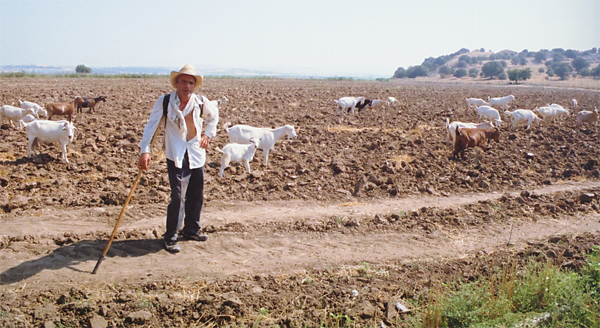
A goatherd with his goats near Troy.
I liked the people here better than the ones I encountered in Istanbul.
During my return layover in Amsterdam I went into the city center again for a few hours. I ducked out of the drizzly weather into an antiquarian bookstore where I found a Dutch translation of The Wizard of Oz. I purchased it as a gift for David, who during the 1980s had what was probably the most extensive collection of Oz and L. Frank Baum books in translation. His collection has been surpassed since, but he still collects Oz translations when he runs across them.
I arrived at JFK airport in New York on the day before the big terrorist scare in the UK, so I wasn't affected by that brouhaha. David, however, who flew to New York City the next day, had to eliminate all containers of liquid from his luggage. I spent a pleasant and productive week and a half in New York, doing research, seeing a couple shows, visiting friends, taking a few classes at Steps on Broadway, and meeting up with my cousin Brian and his German girlfriend Daniele. My book Adventures in Oz was published while I was there, so Jim Hanley's Universe, an excellent comic book shop across 33rd Street from the Empire State Building, hosted a signing, and I did an interview for Ethan Sacks's "Unmasked" column in The New York Daily News online edition.
I ended up making the side trip to Princeton, NJ, for the Munchkin Convention. Anna-Maria Cool Basom was attending in support of the new Oz book she's illustrated, Toto in Oz by Gina Wickwar. I've known Anna ever since we attended The Joe Kubert School of Cartoon and Graphic Art many years ago, but hadn't seen her since the early 1990s. So I went to my umpteenth Oz convention to spend time with her and meet her husband.
David and I drove from New York to Ohio for my grandmother's 90th birthday party. I saw a lot of family that I hadn't seen in years, and met my favorite cousin Carol's four kids for the first time. My sister Elizabeth had flown in, too, with the two gold and two bronze medals she'd just won in the US Masters National Rowing Championship. I also chatted with my cousin Jessica about her experiences winning last year's Miss Tennessee Teen and then First Alternate at Miss Teen America. I'm happy to report that Grandma is doing just fine. We all plan to reunite in ten years for her 100th birthday party.
In Turkey, on the hazy morning that I'd boarded the dolmuş to leave Troy, I'd been surprised at the sharp pain of separation I felt. Although I hoped to return to Troy one day, I didn't know when I'd be back. Every experience I had there enriched me, some in ways I'd expected, others in ways I hadn't anticipated. I didn't want to let go. As the dolmuş drove along the highway toward Çanakkale, I looked back, my sight riveted on the protective covering over the center of the Hill of Hisarlık for as long as it was in view. But my first visit to Troy had ended. Time to move on to the rest of my life.
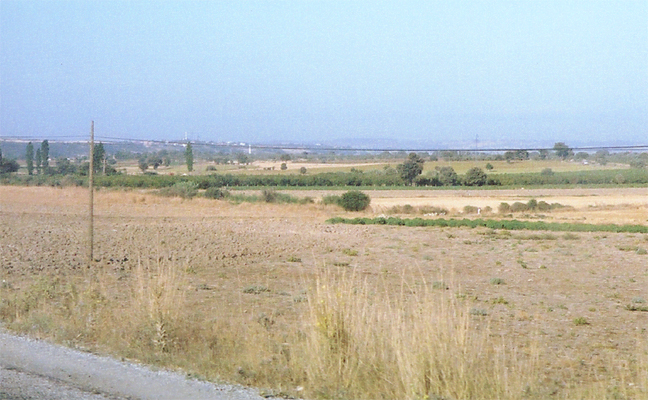
My final view of Troy.
The white protective covering is barely visible in the center just above the power line.
The couple weeks after returning home were difficult. My sojourn at Troy had been such a magnificent experience that all that followed was anticlimax. I felt as though the world should have changed in some significant way, but at home everything was basically the same as it had been before I left. I reluctantly forced myself back into my usual routine.
I'd flown home from New York on a Monday. The very next day, David and I drove to Anaheim, just south of Los Angeles, to set up the Hungry Tiger Press booth for L.A. Con IV, the 64th World Science Fiction Convention. After four weeks of traveling, it was a chore to get geared up for five long days of exhibiting. But I did it and had a good time overall.
One evening at the World Science Fiction Con, I absentmindedly but repeatedly picked at the wart on the index finger of my left hand, the wart I'd been applying fig sap to while at Troy. The next morning, standing inside the exhibit booth, I was surprised to find that a small, firm blister had formed around the wart. I tried not to pop the blister, but somewhere along the way it broke. When the skin of the blister dried, I found that it had lifted the wart from my finger. When I trimmed off the dried skin, the wart was gone! Maybe I'd just irritated the wart in the right way to inadvertently remove it on my own, but I like to think that it was the repeated applications of fig sap in Troy that finally did the trick.
Copyright © 2006 Eric Shanower. All rights reserved.
|
|
|
Home |
Issues |
Books |
T-shirts |
Blog |
Pronunciations |
Our Story So Far
Free Features |
Store |
Privacy |
Links |
Archives
Eric Shanower |
Hungry Tiger Press
All materials are Copyright © 2000, 2001, 2002, 2003, 2004, 2005, 2006, 2007, 2008, 2009, 2010, 2011, 2012, 2013, 2014, 2015, 2016, 2017, 2018, 2019, 2020, 2021, 2022, 2023, 2024, 2025 Eric Shanower. All rights reserved.
The Age of Bronze logo and all prominent characters and their likenesses are trademarks of Eric Shanower.
Image "i" logo is TM and copyright © 1992-2025 Image Comics, Inc.
No portion of this website may be used by generative artificial intelligence without written permission.
Website designed by Digital Sourcery
Contact Webmaster
Contact Eric Shanower
|

|
|
|

